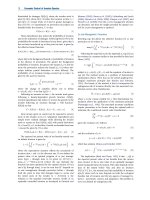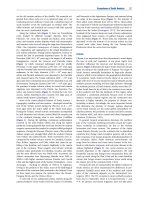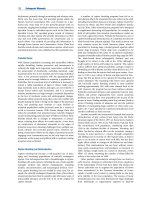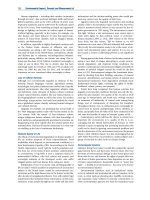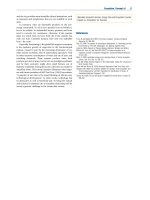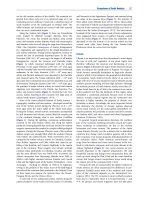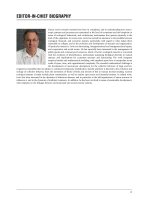Encyclopedia of biodiversity encyclopedia of biodiversity, (7 volume set) ( PDFDrive ) 2987
Bạn đang xem bản rút gọn của tài liệu. Xem và tải ngay bản đầy đủ của tài liệu tại đây (80.49 KB, 1 trang )
Life History, Evolution of
635
Static Environments
combined population. This conclusion does not depend on
the two clones beginning with the same population size: differences in starting condition simply accelerate or retard the
rate at which clone 1 increases in frequency relative to clone 2.
For these two clones, an appropriate measure of fitness is r,
since the frequency of the clone with the highest value of r will
increase toward unity. Thus any mutation in a set of clones
that increases r by changing rates of birth or death will increase in frequency in the population. There are no difficulties
in assigning r as a measure of fitness in the preceding circumstances. Difficulties arise, however, when sexual reproduction and age structure are introduced. Suppose we have a
random mating population in which a mutation arises that
increases birthrate or decreases death rate. Since the mutant
will initially be rare in the population, its fate can be ascertained by considering the birthrates and death rates of the
heterozygote alone. If the heterozygote’s rate of increase is
enhanced, the mutation will increase in frequency in the
population, but its ultimate fate depends on the relative
birthrates and death rates of the homozygotes and heterozygotes bearing the mutant allele. If the homozygote carrying
both mutant alleles has a higher birthrate or a lower death rate
than the heterozygote, the mutant allele will eventually be
fixed in the population; otherwise the population will reach a
stable polymorphism.
The general assumption, stemming from the work of
Fisher, has been that r can be associated with genotypes that
follow particular life histories and that selection will favor that
genotype with the highest value of r. In an age-structured
population, the rate of increase is obtained by solving the
characteristic equation
Z N
eÀrx lðxÞmðxÞdx ¼ 1
ð9Þ
A population growing in an unlimited, homogeneous, and
constant environment follows the simple exponential growth
function
where l(x) is the probability of surviving to age x and m(x) is
the number of female births at age x. The discrete time
equivalent of this is
Figure 2 Distributions of the genetic correlation between
Morphological traits (M Â M) and Life History traits L Â L.
history components, the best example being Fisher’s Malthusian parameter r. Local measures assume that maximization of a fitness component will also maximize the overall
fitness of the organism: for example, a common local measure
used in foraging theory is the net rate of energy intake. This is
an appropriate measure if it can be shown that maximizing
this rate does not detrimentally affect other components of
fitness, in which case maximizing net rate of energy intake will
also increase global fitness.
Local measures are generally tailored for the particular
analysis under consideration, but there now exists a general
consensus, and more important sound theoretical rationale, of
what global measures are likely maximized by natural
selection.
0
dNtị
ẳ rNtị
dt
N
X
erx lxịmxị ẳ 1
10ị
xẳ1
Ntị ẳ N0ịert
6ị
where N(t) is population size at time t and r is the intrinsic rate
of increase, comprising the difference between instantaneous
rates of birth and death. Equation 6 can also be written as
Ntị ẳ N0ịer ịt ¼ Nð0Þlt
ð7Þ
The symbol l is called the finite rate of increase and is
sometimes used instead of r.
Suppose there are two clones with population sizes, N1(t)
and N2(t), respectively, the first with an intrinsic rate of increase of r1 and the second with r2, with r14r2. The ratio of
population sizes after some time t, given that both clones start
with the same population size is,
N1 tị
ẳ er1 r2 ịt
N2 tị
8ị
It is clear that as time progresses this ratio will increase, clone
1 becoming numerically more and more dominant in the
Note that in the discrete version the initial age is subscripted as
1 not 0. The important issue to be considered is the fate of a
mutant that increases r. Charlesworth demonstrated that to a
rough approximation the rate of progress of a rare gene
eventually becomes directly proportional to its heterozygous
effect on r. In this case, the probability of survival of a mutant
gene of small effect in a near-stationary population is largely
determined by its effect on r. Following a more detailed analysis, Charlesworth (1994) concluded
that for the case of weak selection and random mating with respect
to age, the intrinsic rate of increase of a genotype or, more generally,
the mean of the male and female intrinsic rates, provides an adequate measure of fitness in a density-independent and constant
environment.
Lande tackled the problem of applying quantitative genetic
theory to the evolution of r in a population. Assuming weak
selection, large population size, and a constant genetic
